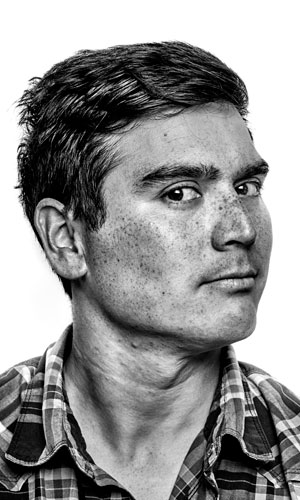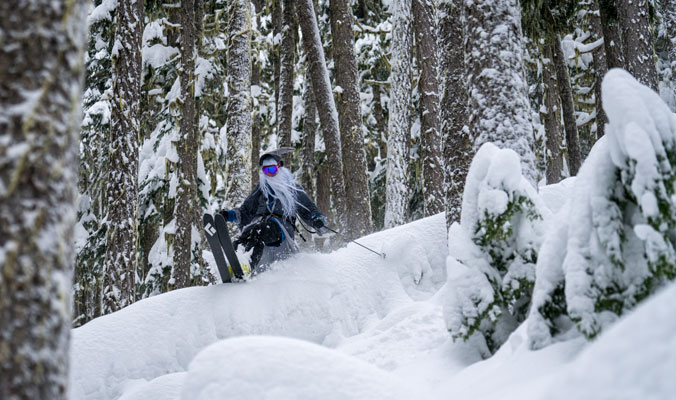Photographer Ming Poon, 36, has curated his life around a love for the mountains. After developing an interest in snowboarding at a young age while growing up in Vermont, Poon moved to California to attend Sierra Nevada College, where he scheduled classes and work to maximize time spent learning other skills, like snow science, safe mountain travel and how to ride in front of the camera. That knowledge, combined with an early interest in photography, became rebooted after Poon returned from four years in China spent working for his father and uncle’s business. After resettling in Tahoe in 2015, Poon immersed himself in photography, this time behind the lens, and with some hard work, stubbornness and advice from his peers, he turned a passion into a career.

As I got more into snowboarding and riding new lines, I was doing it so much that I started to get opportunities to be on the athlete side of the camera. And when a close friend of mine moved to Tahoe and started working for the local paper, I got even more opportunities to be photographed. I didn’t even know it at the time, but I was learning a lot, specifically about how to be on the photographer side of the camera.
When I was growing up, my mom had a Minolta camera, and I got into photography that way, shooting on film. I would shoot wildlife, but I was terrible. I had no one to tell me I was bad, though, so I just loved it. It allowed me to develop my own style, whereas if I had learned in a class at school or through a mentor, then I would just have their style. But doing it the way I’ve done it, I’ve developed my own style and learned along the way. Of course, I have mentors and continue to learn from others, as well.
Digital cameras came out when I was in college, which was amazing. At that point in my life, I was snowboarding a ton and was experiencing all of these things that were new to me, like riding three-foot powder days. We were documenting and just trying to figure out how to store photos on crappy computers. There was zero organization.
I took guide courses, snow-science courses; I got my Avy 1, my Avy 2 and started to get guiding experience on top of my formal training and accreditation. All of that was and still is really important to me, because it makes me a better partner. I started going through this renaissance of learning in the mountains—how to move swiftly in dangerous areas, how to use different tools, how to cut a cornice with a cord. The learning continues.
When we moved back to California from China, I didn’t have a great plan. My wife, Mollie, was like, “What are you going to do?” And I was like, “You know, I think I’m going to take photos and see what happens.” I asked her to give me two years.
I really got into photography that season. I was snowboarding my ass off and going out with all my old friends—Cody Townsend, Michelle Parker, Jeremy Jones, Jim and John Morrison, all those famous people and people who aren’t famous and who are badasses…the dark horses. I’d go with really anybody who was motivated to get out and find good snow and good light, not too hard in Tahoe. I started getting back into the sport and moving in the mountains every day again. I loved it.

At first, looking back on my work, I was terrible at shooting. Mollie and some family and close friends doubted me. She was really nice about it, but it was very clear what she thought. When anyone doubts me like that, I typically take it as a challenge. If you want to, you can pretty much do anything you want. I really believe that. I never lacked motivation.
I reached out to all of these other photographers before I even moved back from China—like Jonah Kessel, a New York Times journalist who I grew up with and lived in China with, Court Leve, Christian Pondella, Adam Clark, Jimmy Chin, Cory Rich, all these guys who are established photographers—and asked them if they thought I could make a living doing this. How did they do it? And I studied them. I took notes on all of their feedback and advice. I still reference those notes and consider them friends and mentors. They all had really good advice, and any of my success stands on the shoulders of those people. Like in any industry, it’s not a coincidence they are successful. Across the board, the advice was: you have to work your ass off, there are better ways to make a living, and it’s pretty much the hardest thing you can do.
So I just worked my butt off and shot and shot. At one point, I felt like I was the only person that believed I could be successful. Turns out, I’m the only person that needed to. But I believe that people can do things that have never been done before or do anything that no one thinks they can do—I learned that through snowboarding and rock climbing. Through climbing I learned you could often do things you didn’t think you could if you give it your all. I learned to be a rebel and not listen to others. You choose to listen to what you want and believe what you want.










Related posts:
Photographer Profile: Grant Gunderson on true locals and finding the sweet spot
Carl Skoog: Remembering an icon of Washington ski mountaineering and photography
Reclaiming Lost Ground, Revisited
Mountain Account: Scott Rokis takes a slide for life on Calif.'s Mt. Williamson